研究成果
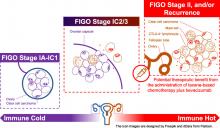
May, 2023
Ovarian clear cell carcinoma (OCCC) is a distinct histotype of ovarian cancer, which usually presages a worse prognosis upon recurrence. Identifying patients at risk for relapse is an unmet need to improve outcomes. A retrospective cohort analysis of 195 early-stage OCCC patients diagnosed between January 2011 and December 2019 at National Taiwan University Hospital was conducted to identify prognostic factors for recurrence, progression-free survival (PFS) and overall survival (OS). Molecular profiling of tumors was performed in a case-controlled cohort matched for adjuvant therapy for biomarker discovery. Multivariate Cox proportional hazard model revealed that paclitaxel-based chemotherapy was associated with better PFS than nonpaclitaxel chemotherapy (HR = 0.19, P = .006). The...
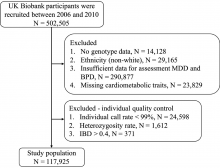
May, 2023
Aims: Cardiovascular diseases (CVDs) are the leading cause of deaths globally. Mortality and incidence of CVDs are significantly higher in people with mood disorders. About 81.1% of CVD patients were reported with comorbidities in 2019, where the second most common comorbidity was due to major depressive disorder (MDD). This study, therefore, aimed to evaluate the genetic correlation between CVDs and mood disorders by using data from the UK Biobank towards understanding the influence of genetic factors on the comorbidity due to CVDs and mood disorders.
Methods: The UK Biobank database provides genetic and health information from half a million adults, aged 40-69 years, recruited between 2006 and 2010. A total of 117,925 participants and 6,128,294 variants were included for analysis after...
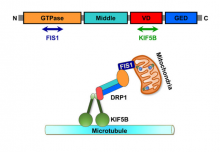
Apr, 2023
Ectopic ATP synthase complex (eATP synthase), located on cancer cell surface, has been reported to possess catalytic activity that facilitates the generation of ATP in the extracellular environment to establish a suitable microenvironment and to be a potential target for cancer therapy. However, the mechanism of intracellular ATP synthase complex transport remains unclear. Using a combination of spatial proteomics, interaction proteomics, and transcriptomics analyses, we find ATP synthase complex is first assembled in the mitochondria and subsequently delivered to the cell surface along the microtubule via the interplay of dynamin-related protein 1 (DRP1) and kinesin family member 5B (KIF5B). We further demonstrate that the mitochondrial membrane fuses to the plasma membrane in turn to...

Apr, 2023
Hearing impairment is one of the most common sensory disorders in children, and targeted next-generation sequencing (NGS)-based genetic examinations can assist in its prognostication and management. In 2020, we developed a simplified 30-gene NGS panel from the original 214-gene NGS version based on Taiwanese genetic epidemiology data to increase the accessibility of NGS-based examinations. In this study, we evaluated the diagnostic performance of the 30-gene NGS panel and compared it with that of the original 214-gene NGS panel in patient subgroups with different clinical features. Data on the clinical features, genetic etiologies, audiological profiles, and outcomes were collected from 350 patients who underwent NGS-based genetic examinations for idiopathic bilateral sensorineural...
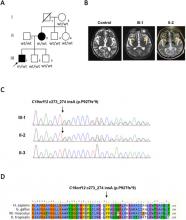
Apr, 2023
Background: Mitochondrial membrane protein‒associated neurodegeneration (MPAN) is a rare genetic disease characterized by progressive neurodegeneration with brain iron accumulations combined with neuronal α-synuclein and tau aggregations. Mutations in C19orf12 have been associated with both autosomal recessive and autosomal dominant inheritance patterns of MPAN.
Methods: We present clinical features and functional evidence from a Taiwanese family with autosomal dominant MPAN caused by a novel heterozygous frameshift and nonsense mutation in C19orf12, c273_274 insA (p.P92Tfs*9). To verify the pathogenicity of the identified variant, we examined the mitochondrial function, morphology, protein aggregation, neuronal apoptosis, and RNA interactome in p.P92Tfs*9 mutant knock-in SH-SY5Y cells...
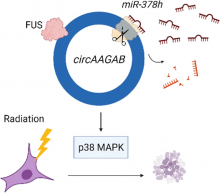
Mar, 2023
Background: Breast cancer is a prevalent disease in women, with high prevalence worldwide. The hypoxic microenvironment of solid tumors develops during the progress of carcinogenesis and leads to greater malignancy and treatment resistance. Recently, accumulating evidence indicates that non-coding RNAs, such as circular RNAs (circRNAs), play a pivotal role in altering cellular functions. However, the underlying mechanisms of circRNAs in breast cancer are still unclear. Therefore, the purpose of this study was to investigate the role of a tumor-suppressive circRNA, circAAGAB, in breast cancer by assuming down-regulation of circAAGAB under hypoxia and the properties of a tumor suppressor. Methods: Firstly, circAAGAB was identified from expression profiling by next generation sequencing...
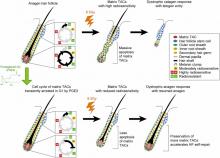
Mar, 2023
Background: Growing hair follicles (HFs) harbor actively dividing transit amplifying cells (TACs), rendering them highly sensitive to radiotherapy (RT). Clinically, there is still a lack of treatment options for radiotherapy-induced alopecia (RIA).
Objective: Our present study aimed to investigated the effect and mechanism of local prostaglandin E2 (PGE2) treatment in RIA prevention.
Methods: We compared the response of growing HFs to radiation with and without local PGE2 pretreatment in a mouse model in vivo. The effect of PGE2 on the cell cycle was determined in cultured HF cells from fluorescent ubiquitination-based cell cycle indicator mice. We also compared the protective effects of PGE2 and a cyclin-dependent kinases 4/6 (CDK4/6) inhibitor against RIA.
Results: The local...
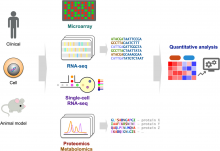
Feb, 2023
The study of multiple “omes,” such as the genome, transcriptome, proteome, and metabolome has become widespread in biomedical research. High-throughput techniques enable the rapid generation of high-dimensional multiomics data. This multiomics approach provides a more complete perspective to study biological systems compared with traditional methods. However, the quantitative analysis and integration of distinct types of high-dimensional omics data remain a challenge. Here, we provide an up-to-date and comprehensive review of the methods used for omics data quantification and integration. We first review the quantitative analysis of not only bulk but also single-cell transcriptomics data, as well as proteomics data. Current methods for reducing batch effects and integrating heterogeneous...
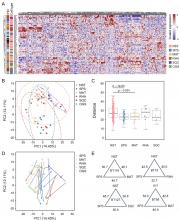
Jan, 2023
Background: Metaplastic breast carcinoma (MpBC) typically consists of carcinoma of no special type (NST) with various metaplastic components. Although previous transcriptomic and proteomic studies have reported subtype-related heterogeneity, the intracase transcriptomic alterations between metaplastic components and paired NST components, which are critical for understanding the pathogenesis underlying the metaplastic processes, remain unclear.
Methods: Fifty-nine NST components and paired metaplastic components (spindle carcinomatous [SPS], matrix-producing, rhabdoid [RHA], and squamous carcinomatous [SQC] components) were microdissected from specimens obtained from 27 patients with MpBC for gene expression profiling using the NanoString Breast Cancer 360 Panel on a NanoString nCounter...
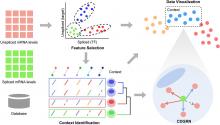
Jan, 2023
The study of multiple “omes,” such as the genome, transcriptome, proteome, and metabolome has become widespread in biomedical research. High-throughput techniques enable the rapid generation of high-dimensional multiomics data. This multiomics approach provides a more complete perspective to study biological systems compared with traditional methods. However, the quantitative analysis and integration of distinct types of high-dimensional omics data remain a challenge. Here, we provide an up-to-date and comprehensive review of the methods used for omics data quantification and integration. We first review the quantitative analysis of not only bulk but also single-cell transcriptomics data, as well as proteomics data. Current methods for reducing batch effects and integrating heterogeneous...